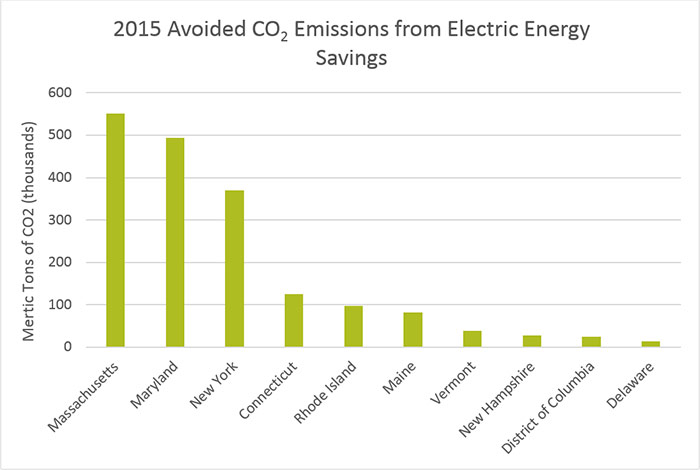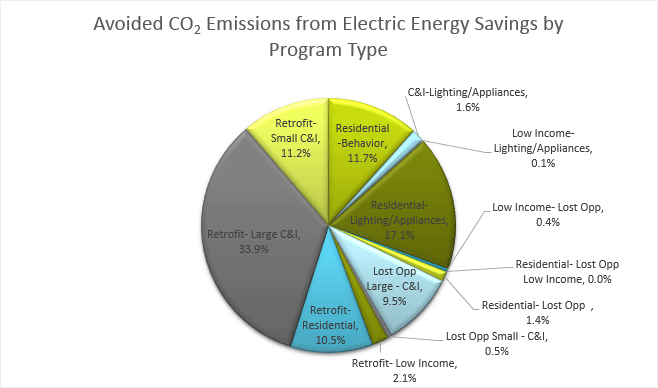By Samantha Caputo | Wed, April 12, 17
Welcome to the first REED Rendering issue of 2017 where we bring your attention to interesting trends that we see in the data and the stories behind those trends.
In the Northeast and Mid-Atlantic, NEEP’s goal is to assist the region in reducing total carbon emissions by 80 percent by 2050, relative to 2001 levels. In doing so, we recognize that energy efficiency is the least cost option for carbon reduction. REED, our Regional Energy Efficiency Database, helps by providing a regional profile of carbon dioxide (CO2) emissions avoided. Read below to see how energy efficiency contributes to this important goal.
The scope of cost-effective energy efficiency is large, with the potential for a substantial percentage of future energy needs being met through efficiency resources. States in the Northeast and Mid-Atlantic are leading in identifying energy efficiency targets, policies and programs. According to the ACEEE State Scorecard, Massachusetts (tied with California) leads at #1, with Vermont following at #3, Rhode Island #4, New York and Connecticut tied for #5, and Maryland at #9. These states are ranked based on strengthening energy efficiency policies and programs, and policymakers recognizing the benefits of these initiatives. It is safe to say the Northeast is a leader.
To see strength in leadership, the table below shows the level of avoided CO2 emissions from electric energy savings in 2015. As a region, 1,825,835.89 tons of CO2 have been prevented from emitting into the atmosphere in 2015 alone. From 2011 to 2015, 17,999,033,397.64 metric tons of CO2 have been avoided from electric energy savings, which is the equivalent to 190,063,711 homes’ energy use for one year!

|
State |
Avoided CO2 Emissions from Energy Savings (Metric Tons) |
|
Massachusetts |
551,542.49 |
|
Maryland |
494,247.68 |
|
New York |
370,197.78 |
|
Connecticut |
125,633.10 |
|
Rhode Island |
97,858.20 |
|
Maine |
82,325.54 |
|
Vermont |
38,885.93 |
|
New Hampshire |
27,069.52 |
|
District of Columbia |
24,833.40 |
|
Delaware |
13,242.24 |
|
Total |
1,825,835.89 |
*Data from the NEEP REED Database
The total avoided carbon for 2015 is equivalent to 385,678 passenger vehicles driven for one year, or 579,440 tons of waste recycled instead of landfilled. Massachusetts leads, with Maryland and New York not too far behind. Let’s take a closer look at these states to see what puts them at the top.

Massachusetts
Recently, Massachusetts adopted the 2015 IECC and 2013 ASHRAE standards as part of the ninth edition of the state’s building energy codes. In 2015, the statewide council savings target as a percent of retail energy sales was 2.6 percent. Achieving high levels of energy savings that lead to avoided carbon emissions is a part of the Global Warming Solutions Act, signed in 2008. Energy efficiency is a major resource within this act with policies implemented through the Clean Energy and Climate Plan for 2020. Through this plan, the combined electric and gas program administrator programs will reduce emissions by an estimated 5.4 MMTCO2e in 2020.
Maryland
Maryland has been quite successful in achieving energy savings through energy efficiency, which has led the state to avoid a substantial amount of CO2 emissions. This has been done through the EmPOWER program. Through this, utilities offer efficiency programs to help save energy in residential, and C&I sectors. Programs include lighting and appliances rebates, HVAC, Home Performance with Energy Star, Star New Homes, combined heat and power, and others. The purpose of EmPOWER is to require utilities to establish programs that encourage cost-effective efficiency use and conservation of energy that lead to a two percent savings of retail electric sales. This program has been so successful, it was recently enacted into law (Senate Bill 185/House Bill 514), which codifies the two percent target of electric energy savings until 2024. Governor Hogan allowed the bill to become law without taking any action on it. In 2015, 87 percent of energy savings came from energy efficiency. In addition, the Greenhouse Gas Emissions Reduction Act requires Maryland to reduce greenhouse gas emissions by 40 percent from 2006 levels by 2030. The EmPOWER program will be an important tool in reaching the 40 percent reduction target by 2030 for Maryland.
New York
In 2008, the New York Energy Efficiency Portfolio Standard (EEPS) proceeding was established as part of a statewide program to reduce New Yorkers' electricity usage 15 percent of forecast levels by the year 2015. In achieving this goal, the total energy savings realized by EEPS electricity programs is equivalent to reducing more than 4.6 million metric tons of CO2. There have been many utility programs put in place to help achieve these savings, including a commercial industrial & process efficiency program, home energy reporting, and large C&I retrofit programs. In New York, a majority of avoided emissions comes from energy savings from the commercial sector.
How it works

The consultants to the Massachusetts Energy Efficiency Advisory Council have conveyed a clear message that there is great opportunity to achieve more savings by converting fluorescent bulbs to LEDS in the C&I sectors over the next couple of years. In the pie chart above, only 1.6 percent of avoided CO2 is attributable to C&I lighting and appliances within the region, making this a relatively untouched area of all states involved. On the other hand, program administrators have seen great success in residential lighting and appliances, with 17.1 percent of savings coming from this sector.
Cutting carbon emissions by 80 percent by 2050 calls for doubling down on energy efficiency, within the program areas seen in the pie chart above, there are programs utilizing advanced metering infrastructure, combined heat and power, air source heat pumps, and Wi-Fi thermostats, for example. In addition, non-wires alternatives and market transformation efforts that would support increases in electric vehicles are among the other strategies that can support this goal.
